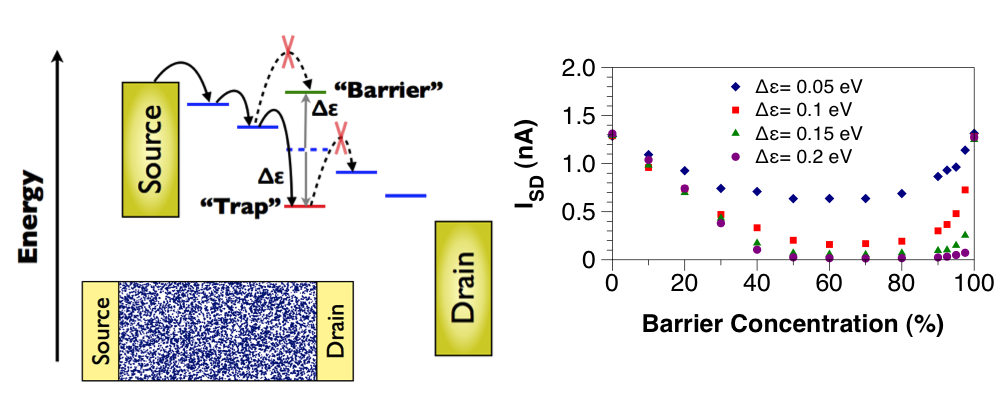Charge Transport in Imperfect Organic Field Effect Transistors: Effects of Charge Traps
Tamika A. Madison, Adam G. Gagorik, Geoffrey R. Hutchison. “Charge Transport in Imperfect Organic Field Effect Transistors: Effects of Charge Traps” J. Phys. Chem. C 2012 116(22) 11852-11858. DOI.
 Monte Carlo simulations were used to study the effects of explicit charge traps on charge transport in small-molecule organic field effect transistors. The results show that the source-drain current decreases as the trap/barrier concentration increases, reaches a minimum around 30/70%, and increases as the concentration reaches 100%, regardless of the trap/barrier distribution. Greater current is predicted for heterogeneous trap distributions than for homogeneous trap distributions, due to wider conduction pathways that allow for more charge carriers to reach the drain electrode. Also, the distributions of distances and potential energy between charge carriers and trap sites were shown to depend on the heterogeneity of the traps and device geometry and, in most cases, are non-Gaussian in shape, due to electrostatic effects between charged traps, unlike previous assumptions. For some ranges of heterogeneity, these densities of states exhibit exponential tails. These results suggest that more experimental work is needed to gain insight into the energetic density of states under operating conditions in electronic devices made from mixed films of organic semiconductors, such as solar cells.
Monte Carlo simulations were used to study the effects of explicit charge traps on charge transport in small-molecule organic field effect transistors. The results show that the source-drain current decreases as the trap/barrier concentration increases, reaches a minimum around 30/70%, and increases as the concentration reaches 100%, regardless of the trap/barrier distribution. Greater current is predicted for heterogeneous trap distributions than for homogeneous trap distributions, due to wider conduction pathways that allow for more charge carriers to reach the drain electrode. Also, the distributions of distances and potential energy between charge carriers and trap sites were shown to depend on the heterogeneity of the traps and device geometry and, in most cases, are non-Gaussian in shape, due to electrostatic effects between charged traps, unlike previous assumptions. For some ranges of heterogeneity, these densities of states exhibit exponential tails. These results suggest that more experimental work is needed to gain insight into the energetic density of states under operating conditions in electronic devices made from mixed films of organic semiconductors, such as solar cells.